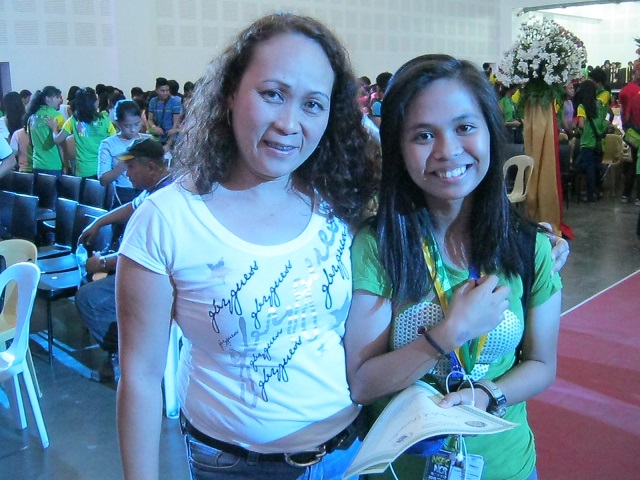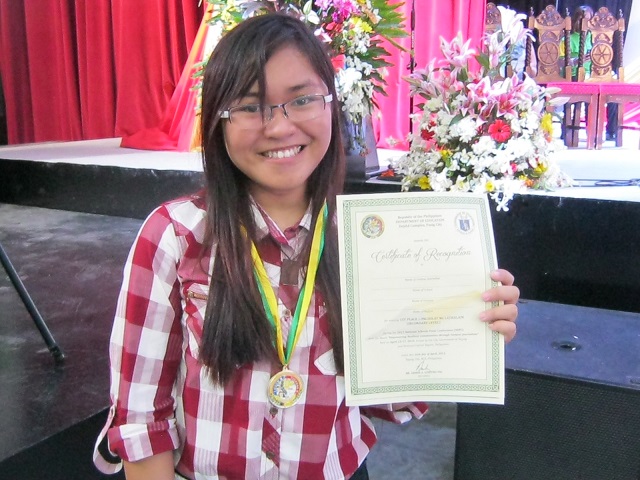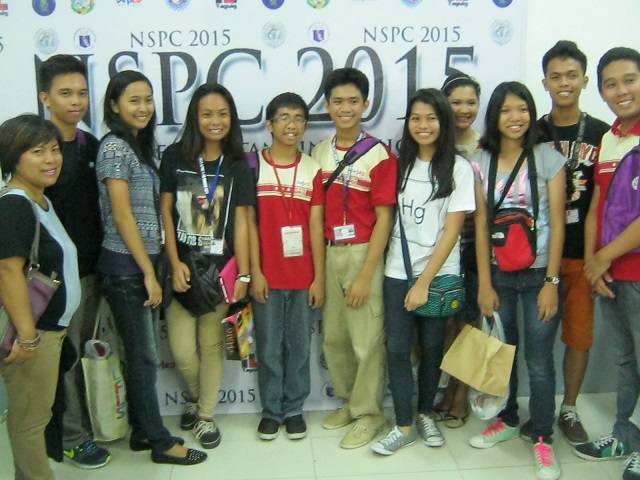Campus journ tilt boosts spirits, skills of young scribes
Familiarity with renewable energy and its impact on Mindanao was, for Jeanne Ellise “Jem” P. Mendoza —a campus journalist from Kidapawan National High School in North Cotabato—key to winning first place in the Filipino category of Science and Health Writing in the 2015 National Schools Press Conference (NSPC).
Taguig City hosted this year's NSPC all of last week and most of the events were at the campus of the Taguig City University, which is located just across the road from Camp Bagong Diwa, headquarters of the Philippine National Police – Special Action Force.
Top seven NSPC winners were declared after several days of competitions in the English and Filipino categories of writing news, editorials, sports, features, science and health, editorial cartooning, photojournalism, collaborative desktop publishing, and radio broadcasting. The school paper competition is held separately but the winners were also announced last week.
Nearly 2,600 students came from elementary schools and high schools from all over the country for this year's NSPC, which was delayed by one week to avoid the hazards of Typhoon Chedeng. The delegates started going home to their respective regions over the weekend.
Second time's the charm

Fortunately for her, the renewable energy topic given last Tuesday was familiar because she wrote about it and won at the division level stage of the NSPC.
Jem said she wrote about solar panels, hydroelectric power produced from the waters of the Maria Cristina Falls, and wind energy, but she was unable to elaborate and enumerate because she “spent too much time collecting her thoughts and rewriting, so she ran out of time.” Solar panels were in her mind, she said, because she saw some on the roofs of houses in Kidapawan.
Contestants are given one hour to write their competition article.
She qualified for the NSPC last year when it was held in Subic. She had just completed Grade 8 back then and had been with the her school's Filipino language school paper, Ang Bukal, only last school year. She was associate editor at the paper.
Jem can still compete next year as she is an incoming Grade 10 student.
Grade 10 students in SY 2015-2016 will be the first batch of students of the new curriculum under the Kindergarten to Grade 12 (K to 12) program of the Department of Education.
Her school paper adviser, Dr. Glady Pagunsan, said Jem will be fielded in the feature writing competitions next time around.

During the Lathalain competition, they were tasked to write about how Filipinos ought to celebrate national holidays. “Hindi ko po na-expect 'yung topic. Ang pinaghandaan ko po ay K to 12, pagsulat ng travelogue, at ang theme ng NSPC 2015.” This year’s NSPC theme was “Empowering Resilient Communities Through Campus Journalism.”
Char recalls that her competition piece was about five to six paragraphs long. She started it off by noting how holidays are now celebrated through social media and cyberspace and the progressed to how the holidays are observed in the real world.
Char recently graduated from high school at the Notre Dame of Tacurong College. She is an incoming freshman at the Notre Dame of Marbel University, where she will pursue an Accountancy degree.
These past several years, the DepEd has been holding the NSPC in April, after the school year is over. Students like Char, still competed at the nationals even though they had finished high school.
Intensive training
Pagunsan was unable to join Jem at the awarding ceremony because he was attending a K to 12 program for trainors from the Visayas and Mindanao.
He credits part of Jem's win to the intensive training their school, Kidapawan National High School (KNHS), and the whole Department of Education in Region 12 implemented for their campus journalists all throughout last school year.
That training, aside from Pagunsan's coaching sessions, included sessions with experienced local journalists and campus journalism trainors of Region 12.
KNHS had three NSPC qualifiers who competed in Taguig.
Pagunsan said he expected Jem to win because “she is very passionate about journalism” and has the right attitude and skills.
Pagunsan also said Jem's parents “are very supportive” of her studies and campus journalism involvement. Jem is enrolled in the science curriculum at KNHS.
Variety of curricula
The DepEd runs more than just the regular curriculum in public high schools. The science curriculum is more intensive in science and math and has tougher academic requirements than the regular curriculum.
There are also “special programs” in journalism, sports, arts, and even foreign languages in select schools per region.
Pagunsan said the Special Program in Journalism or SPJ of Region 12 is in General Santos City.
Budget constraints

Most schools have separate student publications in English and Filipino. Most get to produce only one issue per school year. Some that have more budget, get to churn out two issues.
School paper advisers (SPAs) told GMA News Online that it usually costs around P30,000 to produce one issue. That cost is aside from the expenses incurred when students undergo training and compete in various writing contests.
Most schools depend on the subscriptions collections from parents and students. For grade schools, the DepEd-authorized voluntary subscription fee is P60 per student, while for high schools the rate is P90 per student.
SPAs said the poverty factor affects them because many parents cannot afford the subscriptions and collection is difficult because it is only voluntary.
So the SPAs ask the school principal, parents-teachers associations, financially-able alumni, and local officials for support.
The first wave of campus journalism competitions happen usually from September to October with the district and/or division-level presscons. The regionals take place anytime in November to January depending on the tightness of the local calendars of activities.
Criteria for judging and rating sheets of all presscon competition entries are contained in DepEd Memorandum No. 9, series of 2014. — BM, GMA News





